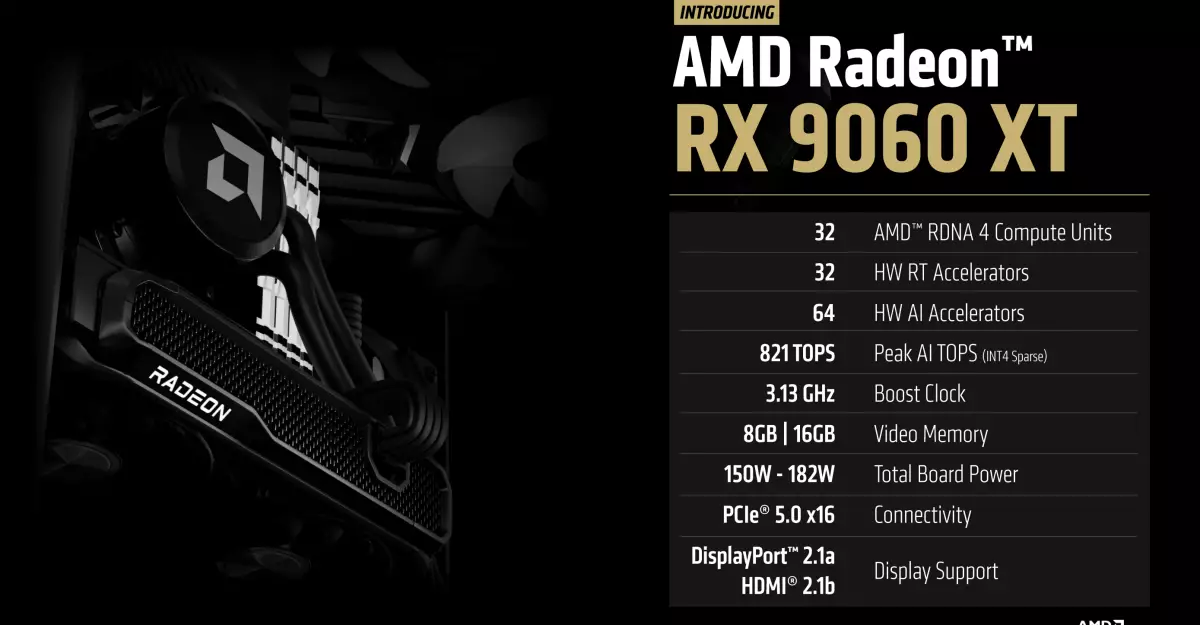In an eagerly anticipated announcement at Computex, AMD has introduced its Radeon RX 9060 XT GPU, a move that signals its intention to directly compete with Nvidia’s RTX 5060. This introduction comes at a crucial juncture, as both tech giants navigate the complex landscape of modern gaming graphics, a battleground characterized by fervent debates around VRAM capacities. The RX 9060 XT boasts configurations with either 8GB or an impressive 16GB of VRAM, positioning it as a formidable counterpart to Nvidia’s recent offering, which has already stirred discontent among gaming enthusiasts for its controversial memory specifications.
The choice to include two distinct VRAM options is strategic, as it not only caters to varying user demands but also capitalizes on the ongoing criticisms toward Nvidia’s decision to limit the RTX 5060 to a mere 8GB. As games continue to demand more from hardware—pushing the thresholds of VRAM utilization—AMD’s development team appears to recognize that future-proofing their product might be a prudent stance. However, the question remains—will this gambit pay off in a market where gamers are increasingly discerning and vocal about performance specs?
Performance Specs: What to Expect from the RX 9060 XT
The Radeon RX 9060 XT is equipped with 32 RDNA 4 compute units and achieves a boost clock speed of 3.13GHz, indicative of AMD’s commitment to delivering robust performance capabilities. Additionally, support for DisplayPort 2.1 and HDMI 2.1 shows that AMD is not just focusing on raw power but also ensuring compatibility with the latest high-resolution displays.
However, one of the most compelling aspects of this GPU is its total board power, which ranges from 150 to 182 watts based on the model selected. This efficiency is crucial as users increasingly seek balance—not only performance but also energy consumption. AMD appears poised to lay out a distinct advantage in an arena where power draw often plays a pivotal role in consumer choice.
The Road Ahead: Significance of Pricing and Release Dates
Despite the technical specifications that reveal promise, AMD has conspicuously withheld crucial details regarding the pricing and release date of the RX 9060 XT. This omission could signal a strategic pause, allowing the company to gauge the reception of Nvidia’s RTX 5060, released mere days prior without any accompanying reviews. The shadow of uncertainty looms, particularly as avid gamers await a detailed assessment of how these two cards truly compare in real-world scenarios.
This withholding tactic may seem calculated, but it could backfire if Nvidia is able to establish its GPU firmly in the market before AMD can capitalize on its latest launch. Moreover, the ongoing backlash against Nvidia from voices like Gamers Nexus adds a layer of complexity to an already charged competition environment. Controversies surrounding Nvidia’s restrictive practices regarding performance benchmarking could provide AMD an opportunity to position itself as a more consumer-friendly alternative, but it remains to be seen how decisively AMD can grasp this chance.
Impact on the Gaming Community and Technology Landscape
As the critical discourse surrounding VRAM and performance expectations continues to evolve, both AMD and Nvidia are embroiled in a battle not just of hardware, but of perception. The gaming community is more engaged and informed than ever, and the ramifications of these GPU releases stretch beyond mere numbers and specs. The choices made by these giants will resonate across gaming platforms and could redefine what players come to expect from their hardware in the years ahead.
AMD’s decision to enter the ring with a potent offering like the RX 9060 XT not only raises the stakes but also reinforces the idea that the competition in the graphics card market is far from stagnant. As gaming technology advances, one thing is clear—the war for your gaming rig is just heating up.

